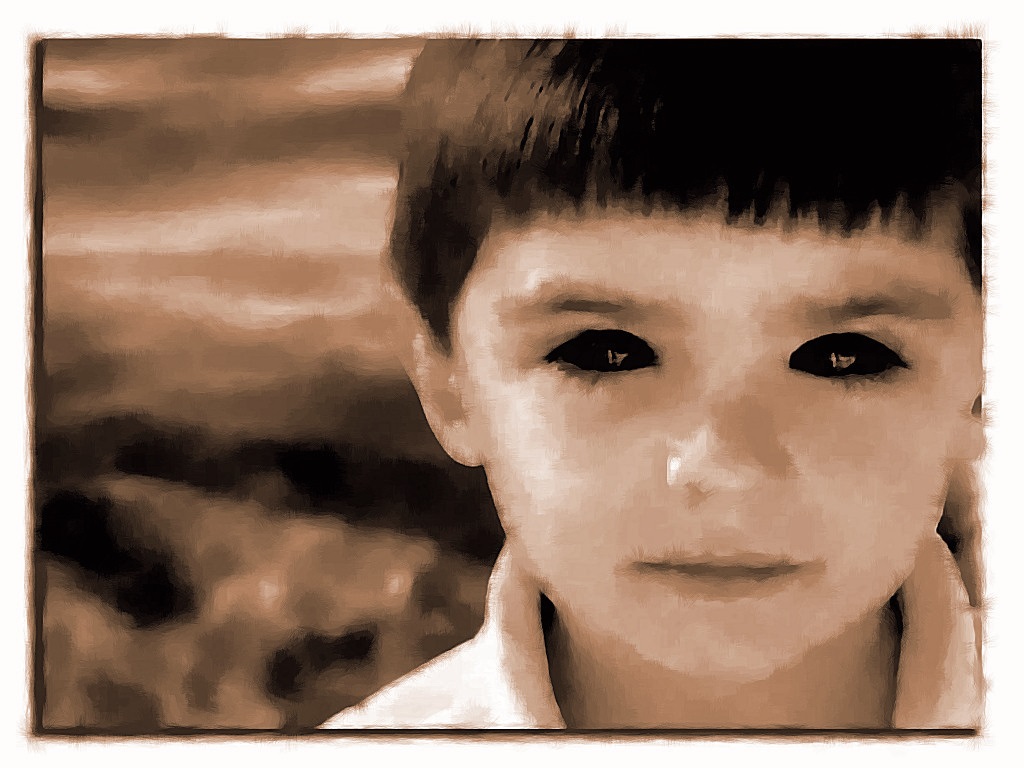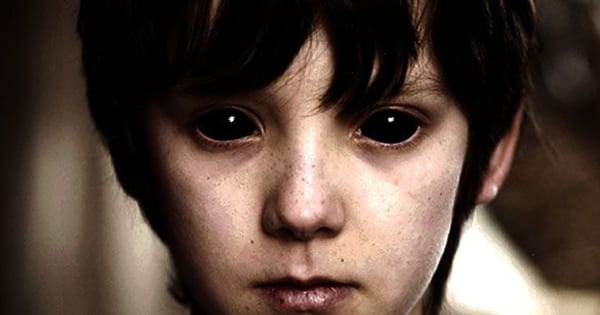Introduction
The eerie whisperings that pass through the shadows of society often birth tales that are both fascinating and unnerving, none more so than the unsettling phenomena of the Black Eyed Children.
This chilling urban legend revolves around encounters with peculiar children whose eyes are as dark as the night sky, inducing a profound sense of dread in anyone who crosses their path.
As a relatively recent phenomenon, the stories of the Black Eyed Children have swiftly cemented their place in contemporary folklore. This legend, seemingly the product of our increasingly interconnected digital age, has sparked curiosity, skepticism, and fear across the globe. It serves as a gripping reflection of our culture’s anxiety and fascination with the unknown and the unexplainable.
In this article, we embark on a journey to the heart of this mystifying tale. We will trace its origins, explore its variations, and delve into its potential meanings and influences.
Furthermore, we will tackle the critical question that rests at the forefront of many minds: are the Black Eyed Children real, or are they merely a product of our collective imagination? Through this exploration, we will strive to grasp the cultural significance of this chilling tale and understand why it continues to grip the public’s imagination.
The Legend of the Black Eyed Children

The narratives surrounding the Black Eyed Children share a hauntingly similar structure, chilling in its simplicity and repetition. Usually, the story unfolds with a late-night knock at the door. An unsuspecting homeowner, or sometimes a lone car driver, opens to find one or more children standing in the darkness.
The ages of these children can vary, though they are often reported to appear anywhere between 6 and 16 years old. They have a peculiarly outdated or unusual manner of speech and dress, creating an unnerving contrast to their apparent youth.
The signature feature of these apparitions, their pitch-black eyes, are typically not revealed immediately. Instead, the children usually keep their gaze lowered or hidden, building a sense of impending dread. They insistently ask for help – a ride home, to use the phone, or to come inside to get something to eat. Despite their seeming vulnerability, the children emanate an inexplicable aura of terror.
The encounters are reported worldwide, from the remote corners of rural Australia to the bustling heart of New York City, but seem to be most concentrated in the United States and the United Kingdom. Variations exist, such as the number of children, their attire, and the exact nature of their requests.
However, these variations do not detract from the core elements of the narrative: the children, their black eyes, their peculiar behavior, and the inexplicable fear they induce. This terrifying consistency only serves to amplify the mystique of the Black Eyed Children phenomenon.
Origins of the Legend
The Black Eyed Children phenomenon as we know it today can be traced back to one chilling account by Brian Bethel, a Texas-based journalist, in 1996. Bethel described an encounter with two such children in the parking lot of a movie theater.
As per his account, the children asked for a ride home to retrieve money for a movie. Despite their seemingly benign request, Bethel was consumed by an irrational fear, ultimately leaving the scene in a hurry.
This encounter, first shared via a chain email and later recounted on various internet forums, laid the groundwork for the myriad stories of Black Eyed Children that would follow. The narrative’s stark simplicity, combined with the intrinsic human fear of the unknown, resonated with readers, and soon accounts of similar encounters began to appear in various corners of the internet, feeding into the legend’s growth and evolution.
A host of theories have been proposed regarding the origins of these tales. Some believe the children to be lost souls or demonic entities, while others speculate extraterrestrial origins. There are also theories suggesting a more psychological basis, like shared cultural fear or mass hysteria.
Regardless of their root, these stories captivate audiences by tapping into a primal fear of the uncanny, of things that seem almost human but are just off enough to be deeply unsettling.
Analysis of the Phenomenon

The Black Eyed Children phenomenon isn’t just another urban legend; it provides a fascinating window into the human psyche and our collective societal fears. As with many legends, part of the traction it gains comes from the elements of truth it contains.
While the children in these tales are portrayed as unearthly, their requests are often mundane: for help, to be let inside a house or car, which starkly contrasts with their terrifying appearances. This disparity allows the stories to take root in our minds, where they resonate with deeply ingrained anxieties.
One of the driving psychological factors behind the popularity of this phenomenon is the fear of the unknown. The children are eerily familiar yet profoundly alien. The contrast between their childlike requests and their chilling appearance exacerbates this fear, creating a sense of uncanny valley – a psychological concept referring to our discomfort with entities that appear almost, but not exactly, human.
Sociologically, these stories exploit our vulnerability concerning the safety of our private spaces. They challenge the sanctity of the home or personal vehicle, presenting scenarios where these havens of safety could be breached by simply succumbing to our instinct to help a child in need. This plays on societal norms and expectations, as well as personal fears and insecurities, adding another layer of unease to the stories.
Furthermore, the accounts often place the storyteller in a position of powerlessness, adding to the feeling of threat and fear. Even though the Black Eyed Children never forcefully enter a home or car, their persistent requests to be let in leave the impression of impending danger, a perceived threat that has proven powerful enough to propagate this urban legend.
Black Eyed Children in Media and Popular Culture
The Black Eyed Children have found their way into various forms of media, serving to enhance and further spread the legend. The impact of these depictions cannot be understated, as they have largely shaped the public’s perception of these eerie figures.
In literature, David Weatherly’s book “Black Eyed Children” has been instrumental in popularizing the phenomenon. Weatherly collects numerous first-hand accounts and explores various theories about the nature and origins of these children. By documenting these encounters, Weatherly’s work has helped solidify the children’s chilling characteristics: their black eyes, their monotone voices, and their peculiar insistence on being invited inside.
Film and television have also explored the Black Eyed Children legend. A notable example is the 2012 independent film, “Black Eyed Kids,” which brings the eerie encounters to life on screen. Similarly, various paranormal-themed TV shows, such as “Paranormal Witness” and “Beyond Belief: Fact or Fiction,” have depicted Black Eyed Children encounters, bringing these chilling tales into the living rooms of audiences worldwide.
The media portrayals have effectively amplified the spookiness of the encounters and, in some instances, added their own interpretations and elements to the existing narratives. By doing so, they have influenced the evolution of the legend, effectively ensuring its propagation across different generations and geographical regions. These media depictions reinforce the chilling aspects of the Black Eyed Children and help to keep the legend alive in popular culture.
Skepticism and Debunking
Given the extraordinary nature of the Black Eyed Children phenomenon, it has naturally attracted a fair amount of skepticism and criticism. The discussions around these accounts typically range from outright disbelief to attempts at providing rational explanations for the reported encounters.
One common rational explanation posits that the encounters are nothing more than misinterpretations or exaggerations of ordinary encounters with children. Critics argue that the mind, particularly when in a state of fear or anxiety, can play tricks and make ordinary situations appear extraordinary. Additionally, the completely black eyes – arguably the most distinctive feature of these children – could be explained by medical conditions like mydriasis or aniridia, or even by the use of contact lenses.
Another prevalent argument is that the stories of the Black Eyed Children are simply urban legends or modern-day folklore, propagated through internet forums and sensationalized by media. Skeptics often point to the lack of concrete evidence, such as photographs or videos, despite the widespread nature of the claims.
The skeptical viewpoint, while sometimes dismissed by believers, plays a crucial role in the discussion around phenomena like the Black Eyed Children. It prompts critical thinking and demands a level of evidence that goes beyond personal anecdotes. This, in turn, fuels a balanced discourse around such phenomena, allowing room for both belief and doubt.
Conclusion
The Black Eyed Children legend – an eerie testament to our love for a good scare. In the face of skepticism and despite zero hard evidence, these unnerving tales have spread like wildfire across continents, fueled by our collective dread of the unknown.
Its growth, enabled by the rapid advance of digital media, mirrors our society’s changing fears and anxieties. This digital-age boogeyman serves as a shared cultural experience that transcends borders, demonstrating our inherent fascination with fear, the unknown, and the thrill of a ghost story told in the dead of night.
True or not, the Black Eyed Children are here to stay in our collective psyche, a chilling reminder of the captivating power of urban legends and the enduring allure of a good, spine-chilling tale.






